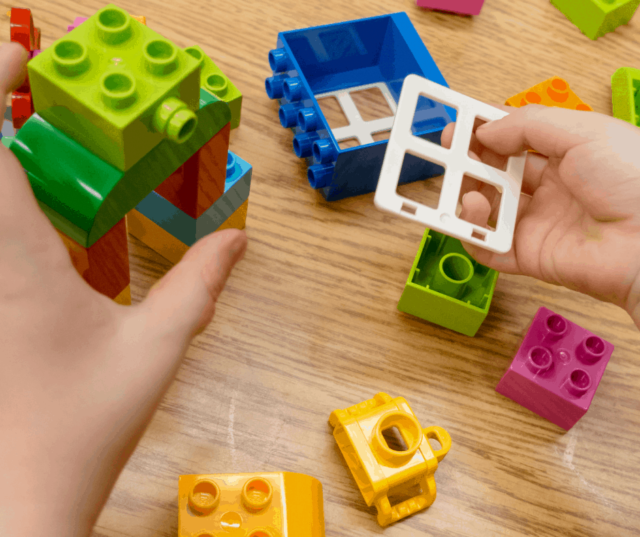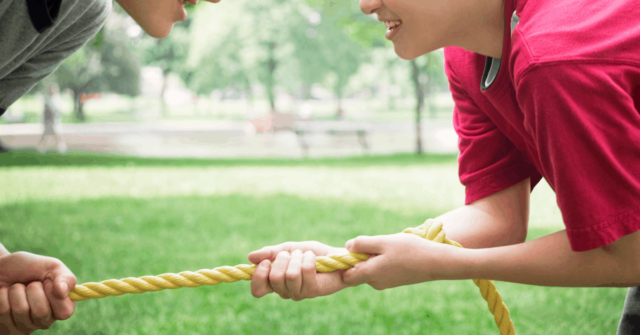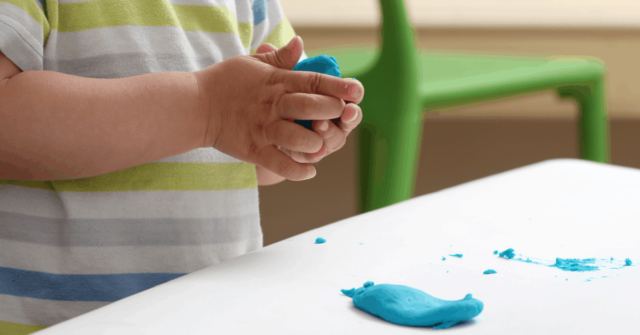Learn what you, as a parent, need to know about bilateral integration and how it can affect your child’s ability to write, read, and even pay attention in school. And, get over 13 easy bilateral coordination activities for your child.
It’s something most parents never give thought to, but it is a critical part of development. So much is happening when our child plays, climbs, and explores their environment. Skills are being honed and used as a foundation for learning in years to come. One of those skills is bilateral integration.
If you haven’t heard of it, or did from a therapist, book, or teacher, then you’re in the right place. Bilateral integration is something pediatric occupational therapists, like myself, are trained to look for, and in this post, you’ll learn what it is, when your child doesn’t have it, and how to help develop this important skill.
What is Bilateral Integration
A baby will hold a block and pass it back and forth from one hand to the other and then a toddler will take a big plastic bead and push it into the next one that it connects with. It’s subtle, but if you really watch a child play, you’ll notice that they typically use both hands.
As a child grows older, a specific coordination develops between both of their hands, and they can easily use their hands simultaneously to complete a task. That is bilateral integration.
But, it doesn’t stop there because bilateral integration is also related to our legs and feet. In the same way, kids need bilateral coordination to crawl, walk, run, and kick a ball.
Why Should You Care About Bilateral Integration?
But, not all kids develop this skill. Not only does it make it really hard to complete necessary life tasks like writing, tying your shoes, and playing a game of soccer, but also, the brain isn’t building the foundation it needs to complete even higher level tasks like reading.
Bilateral integration or coordination is critical because when it happens, the whole brain is being used, not just one side. Besides reading, this can have a large effect on a child’s ability to comprehend told stories, express themselves, and pay attention in a classroom setting.
So, bilateral integration IS very important.
Signs Your Child Needs Help With Bilateral Coordination
Once you start to pay attention to how your child (no matter what age) is playing, you want to see signs that they’re using both of their hands. As babies, this begins with just passing toys from one hand to another. As they become toddlers, you want to see them reaching across the middle of their body for items/toys. This is called “crossing midline” in therapy speak.
It’s a skill we look for as a precursor. Again, once you start to observe your child, do you notice they often leave one hand hanging off to the side or avoid and struggle with activities that require two hands? Those are some signs that they need some specific activities to help support their bilateral integration.
I have to mention that sensory integration can also have a profound impact on bilateral coordination, and I’d consider them through targeted occupational therapy for your child if they seem to have a particularly hard time using both hands together. Some activities that may be hard for a child are:
- Cutting with scissors
- Lacing
- Tying their shoes
- Riding a bike
- Fine motor activities in general
However, difficulty with any of the above activities could also be due to a motor delay, strength, or overall coordination issues. You can find a list of fine motor milestones by age here.
Bilateral Coordination Activities
I’ve got to talk a little more about the sensory aspect of bilateral integration, because the two our intermingled tightly together. Many sensory activities that involve movement such as these proprioceptive and vestibular activities can be used to help the brain develop further. If completing any of the bilateral coordination activities below is really hard and stressful for your child, you may want to focus on these types of activities first.
Remember to NEVER force any sensory activity though.
Possibly in addition to sensory activities to specifically work on and address bilateral coordination, you want to also make sure your child is crossing midline. Some of the activities below include crossing midline, but if they’re particularly challenging for your child, you may want to check out these specific midline activities.
As you can see, there are a couple of layers to bilateral integration. There are three elements you may or may not want to be including in the activities to help your child improve their bilateral coordination:
1. Movement based sensory activities, particularly riding a scooter board on their belly, climbing, and obstacle courses.
2. Midline focused activities like hitting a balloon back and forth or setting up toys their playing with on the opposite side of their body (this forces them to reach across.)
3. Specific bilateral integration activities that directly address using both hands together.
Easy Activities That Require Bilateral Integration:
Affiliate Links used below. See our full disclosure.
- Tearing Paper – Get a box and throw in scrap paper. Make sure some construction paper and heavier weighted papers make it inside. Have a “ripping” party, most kids love the idea of this, but it can be challenging! Start with paper that’s around 5-7 inches in size and show them how to put both hands on each side of the paper, and twist their wrists to get it to rip!
You can incorporate this into a craft too!
2. Stringing Beads – Younger kids can use large wooden beads and pipe cleaners to make the job much more doable. However, depending on the age and skill level of your child, you also want to make sure you’re challenging them just enough. Too hard isn’t good, but neither is too easy. This is a difficult balance, so it may take some trial and error.
3. Wheelbarrow Walking – This is a challenging activity for some kids because it also requires a lot of core strength and motor planning, but it’s worth practicing because the coordinated movements of both hands to accomplish it target bilateral integration directly.
4. Pushing pop beads together and pulling them apart – This cheap classic toy that you can usually find at the dollar store is perfect! For toddlers, make sure you get the larger no-choking hazard versions!
5. Buttoning Buttons – You can work on this while getting dressed, but since most kids don’t wear button down shirts on a regular basis, you may want to sew a button to a piece of ribbon like with this button snake craft. Or, you could try this button link chain. Both will take a little bit of prep work.
6. Playing Catch – Just gold old fashioned catch. Use a larger ball so your child has to catch it with both hands. The twisting, leaping, and stretching with both hands is exactly what we’re aiming for!

7. Building with blocks that stick together – Think Lego, bristle blocks (awesome for toddlers), and Duplo blocks. Although there are lots of other options. Basically, you’re looking for any blocks that hold together and need a bit of a tug to pull apart. It’s nearly impossible to play with these style of blocks without using both hands!
8. Tug-O-War – Grab a jump rope and see if your kid can pull you past the coffee table. This pulls in their whole body and also helps them cross the midline of their body.

9. Make a Mr. Potato Head – Do your kids have one of these laying around? If so, make a point to pull it out and have them push the pieces in, I bet they can’t do that with one hand!
10. Playdough with a purpose – It’s hard to play with Playdough with just one hand, but to make sure you’re getting a lot of bilateral integration practice, show your kid how to:
- Roll a ball
- Make a snake
- Pinch a snake with two hands
- Cut the snake into tiny little pieces with scissors
- Collect all the Playdough pieces and squeeze them into a ball

11. Animal Walk Races – See who can cross the line first while they walk like a crab, bear, snake, or horse. Tons of movement across the body to work on bilateral integration in a fun way!
12. Hidden Treasure – Take some coins, beads, or other small objects and hide a few in a ball of putty. Challenge your child to get them out! The pulling and twisting is perfect for bilateral coordination strengthening, but it also helps strengthen the muscles in the hand for fine motor skills. I love this therapy grade putty, it stays a little cleaner and has some resistance built into it.
13. Build an Obstacle Course – Crawling, climbing, balancing, and throwing are all great ways to strengthen bilateral coordination. You can combine these easily when you pull together stuff you already have from around the house. Couch cushions, pop up tunnels, a broom for a balance beam, and other items can be used in a pinch.
Get inspired with these easy obstacle courses here.
What if My Child Needs Help Doing These Bilateral Coordination Activities?
It’s okay if you’re child needs some help. Sometimes you have to give it or they’ll get too frustrated and quit. At the same time, you don’t want to jump in too fast. This is the balance that all therapists try to strike and it can get tricky. It’s okay if you don’t always get it “right,” in fact, you won’t.
But, being aware of how much to help and when it’s really needed will help your child build those bilateral coordination skills quicker!
Help for Bilateral Coordination Challenges
As I mentioned earlier, if you suspect that your child has difficulty using both sides of their body, it never hurts to get an evaluation from an occupational therapist. Ask your pediatrician about the next step for your local area.
And, if sensory integration is new to you, you’ll want to see if there are any other sensory red flags going on with your child that you may be missing! I’ll send it right to your inbox.
Click here to get the printable 21 Sensory Red Flags You Might Be Missing
More on Sensory Integration
What Parents Need to Know About Sensory Dysregulation
37 Sensory Toys to Help Kids Learn, Communicate, and Calm Down
How to Help a Child with Sensory Sensitivities
100+ Awesome and Easy Sensory Diet Activities
Alisha Grogan is a licensed occupational therapist and founder of Your Kid’s Table. She has over 20 years experience with expertise in sensory processing and feeding development in babies, toddlers, and children. Alisha also has 3 boys of her own at home. Learn more about her here.
